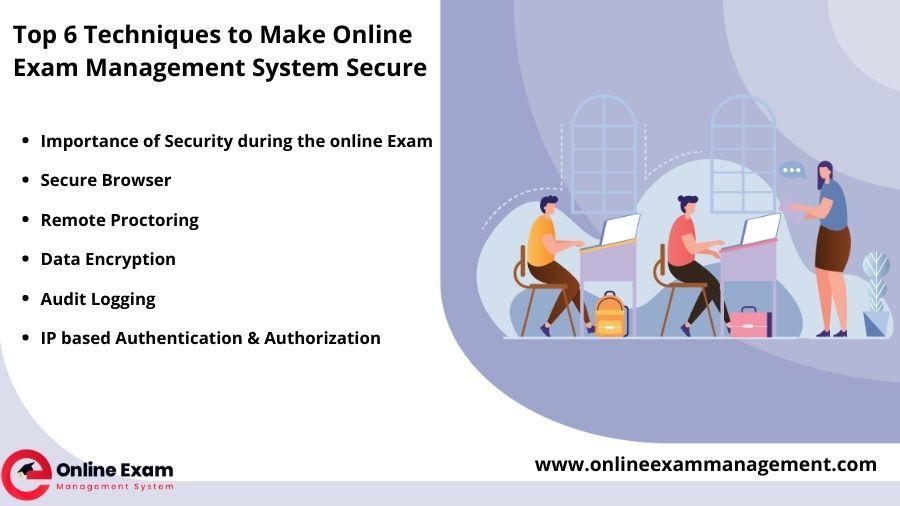
Top 6 Techniques to Make Online Exam Management System Secure
The traditional paper-based examination is being replaced with online examination because of its numerous and in contrast to benefits. It offers a good mechanism to conduct exams with a reduced administrative cost.
The majority of the entrance exams in education institutes, recruitment exams for hiring, certification exams from professional certification authorities, and psychometric tests to assess personality are conducted online.
While switching from traditional exams to online exams you wish to make sure that technology implements best practices of security and it’s being verified with a particular use case of application security.
Buy Now – Online Exam Management Plugin
1. Importance of Security during the Online Exam
Online examination system offers scalability and adaptability to manage the end-to-finish process of question paper patterns to process the results. Exam security means taking measures that make sure that the test is conducted fairly. There should be no scope for cheating by the students while they offer the online exam.
Therefore, the safety aspect of the online examination process is critical for overcoming malpractices or unauthorized access to the data.
2. Secure Browser
Secure Browser Technology prevents users from opening the other window while the online examination process goes on. Access to keyboard shortcuts for copy, paste, and screen capture is prevented. There is a feature that will show a warning message to the user when the user tries to move removed from the exam window.
It prevents the user from opening other windows during the online exam process. It is possible to own a custom app pre-installed on the machine. The user will appear for the exam from the identical app. This app prevents Screen Capturing, Recording, and Remote Login features. It helps to secure your Online Exam Process.
Also Read Latest Post: Top-10-features-of-online-exam-management-system
3. Remote Proctoring
The online examination process will be automated for the invigilation or proctoring process. In the Remote Proctoring system, a supervisor isn’t required to be present at the examination center.
It includes the three main processes and these are here:
a) Image Capturing :
The system captures images of the candidate appearing for the exam after certain intervals (e.g. 30 seconds). It helps to spot and authorize exam candidates sitting at a far-off location.
b) Video Streaming:
Online Examination systems also can stream videos of the candidate. Remote Proctor can log in to the system to test the live streaming of the candidate.
This technology is extremely helpful when students are taking exams from remote locations. The proctor can easily keep a tab on students through their web cameras. This also helps to avoid wasting lots of logistical costs.
c) Screen Capturing:
Proctoring will be done even by taking screenshots of the screens of the student’s current access.
d) Voice Proctoring
Proctor may also hear the voice of the user attempting the exam. It also records the voice within the system for verification purposes.
Suggest Post: Importance of online examination in India
4. Data Encryption
The online examination system’s data has been encrypted to stop any reasonable misuse. Question Bank and exam data are stored in a highly secure and encrypted manner.
Encryption plays a vital role in preventing unauthorized access to question banks. It also helps to avoid result manipulation without valid credentials. It’s an important feature to ensure the safety of the examination.
The complete communication between the server and examination client is additionally encrypted with a secure mode of communication. This ensures the secrecy of the question papers. High-level encryption algorithms are wont to encode data that can’t be decoded easily. This assures the safety of the examination data to its maximum.
5. Audit Logging
Online Examination System provides an in-depth audit logging facility where activities like Login, Logout, Exam Access, Question Navigation, etc. are recorded within the system. The system also records details of activities like Question Navigation, Section Changes, and Internet Speed.
Using techniques like geotagging it’s possible to trace the exact location of the user during online exam activity. To carry on the successful Audit Logging procedure, you must fulfill the given below requirements:
- The candidate logs in to the system using valid credentials.
- On Successful Login, the candidate needs to enter a valid card number within the system
- The system then validates this card number with the main points provided during registration. as an example, if the candidate has submitted their PAN number while registering, then the system will compare the entered details with the records available.
- After the entered details are verified, candidates have to show them, say, a PAN card to the remote proctor for verification.
- If the identity isn’t valid then the remote proctor may reject it. The candidate must redo the method of showing his/her ID to a foreign proctor.
Also, Read: Reason to choose an online exam management software
6. IP-based Authentication & Authorization
The concept of IP Authorization and Authentication means the access and operation of the examination program and is also limited to a particular specified number of IP addresses. This enables access only to certain specific IP addresses and ensures complete safety for the examination.
Secure Online exam process is important if you would like to get a bonus from technology usage. Employing best practices of online exam security can help to manage the examination process with the very best security.
It can prevent the misuse of technology and also the prevention of cheating may be achieved.

